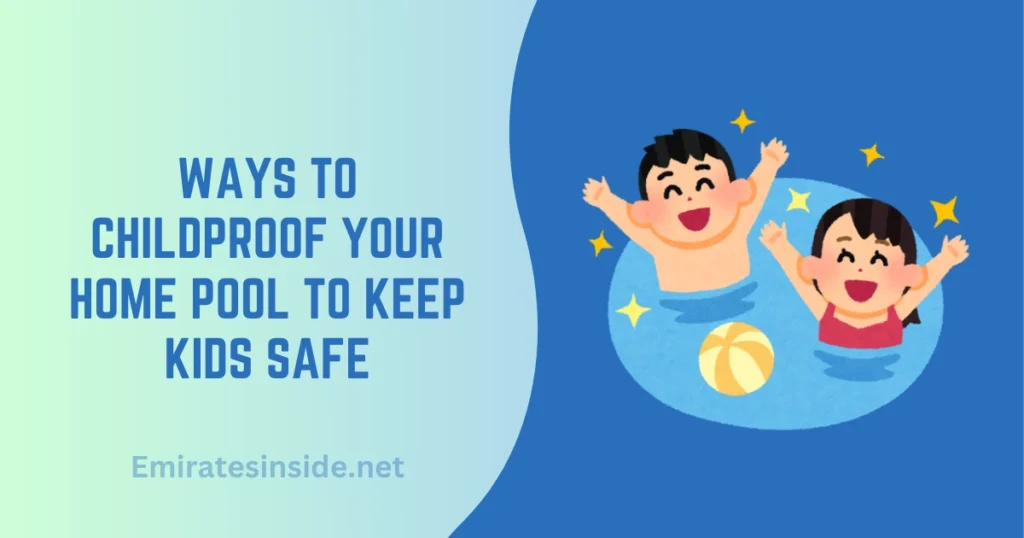Ways to Childproof Your Home Pool to Keep Kids Safe
Having a swimming pool at home is a great way to enjoy fun and relaxation, but it also comes with serious responsibility, especially if you have children. A backyard pool can be a wonderful place to create family memories, but without proper safety measures, it can quickly become dangerous. Every year, many accidents occur due to children accessing pools unsupervised. That’s why childproofing your pool area is absolutely essential.

Even if your child knows how to swim, that alone isn’t enough. Children can slip, fall, or get tired while swimming. Supervision is crucial, but accidents can happen in just seconds. The good news is that there are many effective, practical ways to make your pool area safer for kids. From installing fences and alarms to teaching swimming skills and using safety covers, these steps can give you peace of mind.
In this article, we’ll explore 10 smart and simple ways to childproof your pool area at home by swimming pool companies in Dubai, so your backyard stays a safe, enjoyable space for the whole family.
1. Install a Four-Sided Pool Fence
A secure fence around your pool is one of the most important safety measures you can take. Experts recommend a four-sided isolation fence that separates the pool from the rest of the yard and the house. This barrier greatly reduces the chances of a child wandering into the pool area unsupervised.
The fence should be at least 4 feet tall, with self-closing, self-latching gates that open outward and are placed high enough so small children can’t reach them. Choose materials that don’t allow climbing, like vertical bars or mesh panels, to prevent kids from using the fence as a ladder.
2. Use a Pool Safety Cover
A strong, secure pool safety cover can prevent children from falling into the water when the pool isn’t in use. These aren’t the same as standard tarp covers or solar blankets—safety covers are designed to support the weight of a child or even an adult in case of an accidental step or fall.
Look for a cover that anchors firmly to the ground and doesn’t sag under weight. Mesh covers are great for letting rainwater through without creating puddles, while solid covers block light and reduce algae growth.
3. Install Pool Alarms
Alarms act as a second line of defense when physical barriers fail. There are several types of pool alarms available:
- Gate alarms alert you when the fence gate is opened.
- Surface wave alarms detect ripples when someone or something enters the water.
- Subsurface alarms sense underwater movement.
- Wearable alarms can be attached to your child and sound if they get wet.
Using alarms in combination with other safety measures provides layered protection and gives you extra time to react if a child gets too close to the pool.
4. Add a Pool Door Alarm or Lock
If your house opens directly onto the pool area, every door leading outside should have an alarm or childproof lock. Install alarms that make a loud noise when opened, or consider doors with automatic locking mechanisms. This way, you’ll be instantly alerted if a child tries to go outside without supervision.
Locks should be high up on the door, well out of reach of small hands. You can also add sliding door locks or motion detectors to increase safety.
5. Use Pool Safety Nets
Pool safety nets are another excellent tool for childproofing. These nets stretch tightly over your pool and prevent kids from falling in while still allowing you to enjoy an unobstructed view of the water. They’re ideal for families who don’t want a permanent fence or cover and need a solution that can be easily removed by adults.
The net holes are small enough to prevent children from slipping through and strong enough to hold their weight if they fall. Be sure to use nets that meet industry safety standards and are properly anchored.
6. Design a Slip-Resistant Pool Deck
Slippery surfaces increase the risk of falls, especially when kids are running or playing near the water. Choose materials that are non-slip or textured, like broom-finished concrete, rubber coatings, or stone tiles with grip with the help of swimming pool renovation companies.
You can also apply anti-slip coatings or mats to existing pool decks. Not only does this reduce accidents, but it also makes your pool area safer for guests of all ages.
7. Remove Tempting Toys When Not in Use
Children are naturally curious, and floating pool toys can attract them to the water when no one is watching. After swimming, always remove toys, floaties, and balls from the pool and store them out of sight.
This simple step removes temptation and reduces the chance of a child entering the water while trying to retrieve a toy. A clean pool also makes it easier to spot someone in trouble.
8. Teach Kids to Swim Early and Safely
Swimming lessons don’t make a pool completely safe, but they do help your child become more comfortable and capable in the water. Many experts recommend starting swimming lessons by age 1, depending on the child’s readiness.
9. Supervise at All Times
Even with all the safety measures in place, nothing replaces active adult supervision. When kids are in or around the pool, always watch them closely and avoid distractions like phones or reading. Drowning can happen in silence and in less than a minute.
10. Take a CPR and First Aid Class
As a parent or caregiver, it’s wise to learn CPR (cardiopulmonary resuscitation) and basic first aid. In a pool emergency, a few seconds can make the difference between life and death. Knowing what to do can help you respond quickly and effectively before emergency services arrive.
Many community centers, hospitals, and online programs offer CPR certification for parents, grandparents, and babysitters. Keep a first-aid kit and emergency contacts near your pool area.
Childproofing your pool area for villa renovation in Jumeirah Islands is not just about following rules—it’s about protecting the people you love most. Pools can be a source of endless joy, but they must be treated with care and respect, especially when young children are involved.
By combining physical barriers like fences and covers with smart tools like alarms and supervision, you create a safe environment where kids can enjoy the water without unnecessary risk. Add in swimming lessons, non-slip surfaces, and a little planning, and your backyard can become both a fun and secure space.





